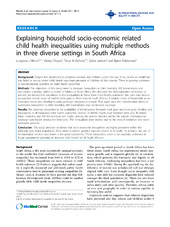| dc.contributor.author | Nkonki, Lungiswa Leonora | en_US |
| dc.contributor.author | Chopra, Mickey | en_US |
| dc.contributor.author | Doherty, Tanya Mark | en_US |
| dc.contributor.author | Jackson, Debra | en_US |
| dc.contributor.author | Robberstad, Bjarne | en_US |
| dc.date.accessioned | 2012-02-06T11:22:26Z | |
| dc.date.available | 2012-02-06T11:22:26Z | |
| dc.date.issued | 2011-04-04 | eng |
| dc.Published | International Journal for Equity in Health 2011, 10:13 | en |
| dc.identifier.issn | 1475-9276 | |
| dc.identifier.uri | https://hdl.handle.net/1956/5552 | |
| dc.description.abstract | Background: Despite free healthcare to pregnant women and children under the age of six, access to healthcare has failed to secure better child health outcomes amongst all children of the country. There is growing evidence of socioeconomic gradient on child health outcomes Methods: The objectives of this study were to measure inequalities in child mortality, HIV transmission and vaccination coverage within a cohort of infants in South Africa. We also used the decomposition technique to identify the factors that contribute to the inequalities in these three child health outcomes. We used data from a prospective cohort study of mother-child pairs in three sites in South African. A relative index of household socioeconomic status was developed using principal component analysis. This paper uses the concentration index to summarise inequalities in child mortality, HIV transmission and vaccination coverage. Results: We observed disparities in the availability of infrastructure between least poor and most poor families, and inequalities in all measured child health outcomes. Overall, 75 (8.5%) infants died between birth and 36 weeks. Infant mortality and HIV transmission was higher among the poorest families within the sample. Immunisation coverage was higher among the least poor. The inequalities were mainly due to the area of residence and socioeconomic position. Conclusion: This study provides evidence that socio-economic inequalities are highly prevalent within the relatively poor black population. Poor socio-economic position exposes infants to ill health. In addition, the use of immunisation services was lower in the poor households. These inequalities need to be explicitly addressed in future programme planning to improve child health for all South Africans. | en_US |
| dc.language.iso | eng | eng |
| dc.publisher | BioMed Central | eng |
| dc.rights | Attribution CC BY | eng |
| dc.rights.uri | http://creativecommons.org/licenses/by/2.0/ | eng |
| dc.title | Explaining household socio-economic related child health inequalities using multiple methods in three diverse settings in South Africa | en_US |
| dc.type | Peer reviewed | |
| dc.type | Journal article | |
| dc.description.version | publishedVersion | en_US |
| dc.rights.holder | Copyright 2011 Nkonki et al; licensee BioMed Central Ltd. | |
| dc.identifier.doi | https://doi.org/10.1186/1475-9276-10-13 | |
| dc.identifier.cristin | 844835 | |
| dc.subject.nsi | VDP::Medical disciplines: 700::Health sciences: 800::Community medicine, Social medicine: 801 | eng |

